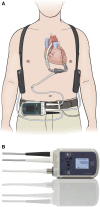Left Ventricular Assist Devices and the Kidney
- PMID: 29070522
- PMCID: PMC5967423
- DOI: 10.2215/CJN.04670417
Left Ventricular Assist Devices and the Kidney
Abstract
Left ventricular assist devices (LVADs) are common and implantation carries risk of AKI. LVADs are used as a bridge to heart transplantation or as destination therapy. Patients with refractory heart failure that develop chronic cardiorenal syndrome and CKD often improve after LVAD placement. Nevertheless, reversibility of CKD is hard to predict. After LVAD placement, significant GFR increases may be followed by a late return to near baseline GFR levels, and in some patients, a decline in GFR. In this review, we discuss changes in GFR after LVAD placement, the incidence of AKI and associated mortality after LVAD placement, the management of AKI requiring RRT, and lastly, we review salient features about cardiorenal syndrome learned from the LVAD experience. In light of the growing number of patients using LVADs as a destination therapy, it is important to understand the effect of these devices on the kidney. Additional research and long-term data are required to better understand the relationship between the LVAD and the kidney.
Keywords: Acute Kidney Injury; Cardio-Renal Syndrome; Chronic; Heart Transplantation; Heart-Assist Devices; Humans; Incidence; LVAD; Renal Insufficiency; Renal Replacement Therapy; cardiorenal; cardiovascular disease; congestive heart failure; glomerular filtration rate; kidney.
Copyright © 2018 by the American Society of Nephrology.
Figures


References
-
- Roger VL, Weston SA, Redfield MM, Hellermann-Homan JP, Killian J, Yawn BP, Jacobsen SJ: Trends in heart failure incidence and survival in a community-based population. JAMA 292: 344–350, 2004 - PubMed
-
- Rose EA, Gelijns AC, Moskowitz AJ, Heitjan DF, Stevenson LW, Dembitsky W, Long JW, Ascheim DD, Tierney AR, Levitan RG, Watson JT, Meier P, Ronan NS, Shapiro PA, Lazar RM, Miller LW, Gupta L, Frazier OH, Desvigne-Nickens P, Oz MC, Poirier VL; Randomized Evaluation of Mechanical Assistance for the Treatment of Congestive Heart Failure (REMATCH) Study Group: Long-term use of a left ventricular assist device for end-stage heart failure. N Engl J Med 345: 1435–1443, 2001 - PubMed
-
- Hasin T, Topilsky Y, Schirger JA, Li Z, Zhao Y, Boilson BA, Clavell AL, Rodeheffer RJ, Frantz RP, Edwards BS, Pereira NL, Joyce L, Daly R, Park SJ, Kushwaha SS: Changes in renal function after implantation of continuous-flow left ventricular assist devices. J Am Coll Cardiol 59: 26–36, 2012 - PubMed
-
- Slaughter MS, Rogers JG, Milano CA, Russell SD, Conte JV, Feldman D, Sun B, Tatooles AJ, Delgado RM 3rd, Long JW, Wozniak TC, Ghumman W, Farrar DJ, Frazier OH; HeartMate II Investigators: Advanced heart failure treated with continuous-flow left ventricular assist device. N Engl J Med 361: 2241–2251, 2009 - PubMed
Publication types
MeSH terms
LinkOut - more resources
Full Text Sources
Other Literature Sources
Medical

